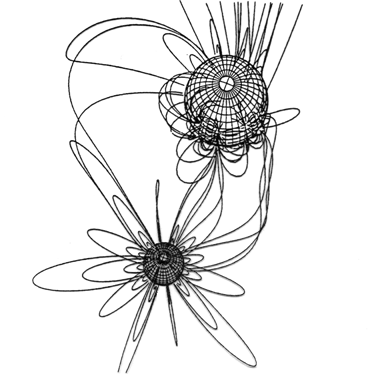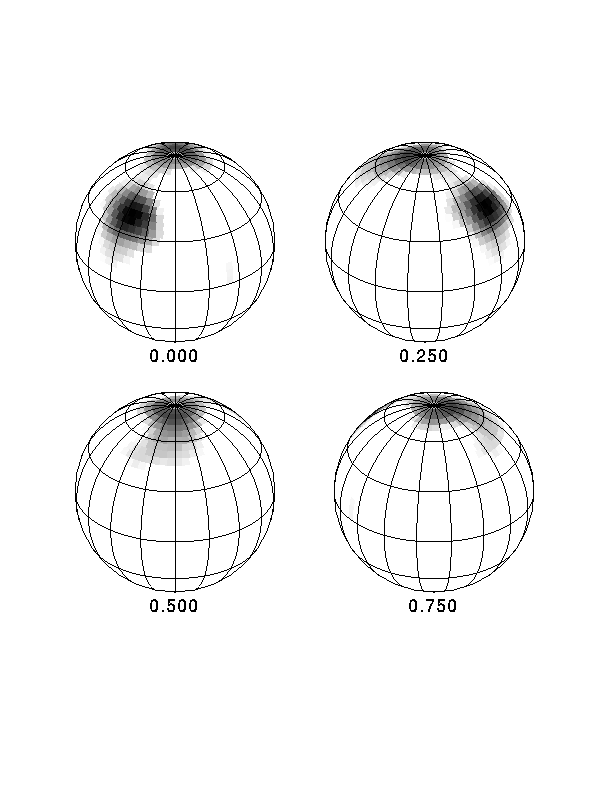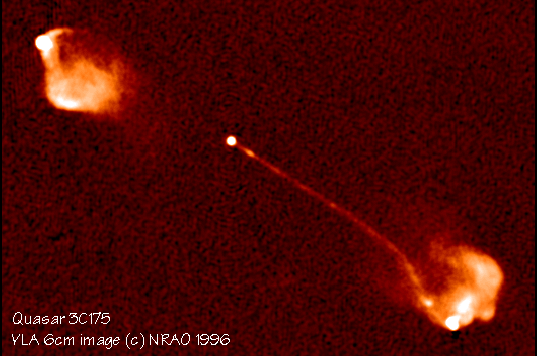A good place to
start with stellar radio emission is to look at an H-R diagram.
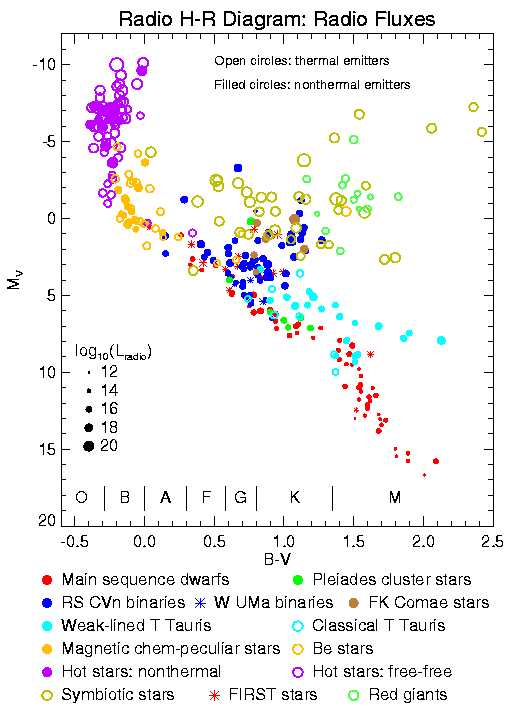 This diagram is from Stephen
White, when at University of Maryland (now at Air Force Research Lab). The placement of the symbols is
according to the star's classical visual magnitude vs. color (B-V), but
the symbols themselves encode the information about the radio emission.
Most of the main sequence and subgiant objects are nonthermal emitters
(filled circles), while most of the giants and many of the O-B stars are
thermal emitters (simply because they are big). The blue circles
near the center of the diagram are RS
CVn binaries. These have a late-type subgiant "revved up" by
tidal interactions with its close binary companion, as shown in the two figures below. The open circles
in the above figure, just above the RS CVn ones, are symbiotic stars, which again are binaries,
but now with a compact companion (perhaps a black hole).
This diagram is from Stephen
White, when at University of Maryland (now at Air Force Research Lab). The placement of the symbols is
according to the star's classical visual magnitude vs. color (B-V), but
the symbols themselves encode the information about the radio emission.
Most of the main sequence and subgiant objects are nonthermal emitters
(filled circles), while most of the giants and many of the O-B stars are
thermal emitters (simply because they are big). The blue circles
near the center of the diagram are RS
CVn binaries. These have a late-type subgiant "revved up" by
tidal interactions with its close binary companion, as shown in the two figures below. The open circles
in the above figure, just above the RS CVn ones, are symbiotic stars, which again are binaries,
but now with a compact companion (perhaps a black hole).
|
|
| Left: Model of an RS CVn binary, showing interactions between stars due to their high field strengths and close proximity. |
Right: Star spot mapping of the surface of one component of an RS CVn binary, showing that 10-20% of the stary may be
covered with spots. The spot size and location is determined from eclipses and rotational modulation. |
Note that the G, K and M
dwarfs (red dots) are weak emitters. These objects are also flare
stars, meaning that occasionally they have strong radio outbursts.
Why should red dwarfs have large flares? You can calculate how strong
the Sun's radio outbursts would appear if observed from the distance of
the nearest stars, and you will find that they are barely detectable.
Flare stars, on the other hand, have both optical and radio flares that
are giant in comparison to solar flares. There is good evidence that
such stars have a large fraction of their surfaces covered with "sunspots."
This is probably due to their having fast rotation coupled with a fully
convective interior, so that dynamo generation of magnetic fields is much
larger than for the Sun. A few stars have so much activity that they
can be said to have detectable "quiescent" radio emission all of the time
(e.g. the star UV Cet). Here
is a report of an intense flare on the flare star AD Leo, reaching
a probable brightness temperature of 1013
K. ALMA provides extremely high spatial resolution images of protoplanetary disks
like this icy dust ring around the star Fomalhaut.
Here is a gallery of images from ALMA.
When a star's mass
at the end of its life is M > 1.4 Mo,
electron degeneracy is no longer enough to keep gravity at bay, and matter
is crushed to force inverse β
decay
p+
+ e- ---> n + ν.
(ν is a neutrino)
so the protons and electrons
are combined to form neutrons--a neutron star. The state of matter
is a neutron degenerate gas. Degenerate objects have the peculiar
property that with greater M they have smaller radii, up to ~ 3
Mo.
Radii are typically 10-30 km.
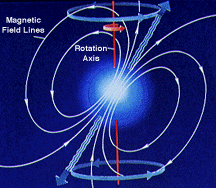
Pulsars are rapidly rotating
neutron stars that have a very high magnetic field (concentrated during
the collapse of the core of a star into a neutron star) whose poles happens
to be offset from the direction of the spin axis. If the spinning
happens to bring the poles around to point at Earth, we will see these
bright poles briefly as an intense radio emitting source. The emission
is due to synchrotron emission of electrons in the high magnetic fields.
The pulses, of course, are repeated on each spin. The pulses suffer dispersion as they travel through the interstellar medium. The properties of the dispersion allow the column density of electrons between us and the pulsar to be deduced.
Pulsars spin at
periods ranging from 4 s to 1.6 ms. Here is how they sound:
pulsar
sounds
You can imagine the forces
on the fastest pulsar. The surface speed is v = 2πR
/ P, where P
is the pulsar period and R is the pulsar radius (about 10 km = 104
m):
v = 2πR
/ P = 2π(104
m) / 0.0016 s = 3.9 x 107 m > 0.1
c.
Its centripetal acceleration
is ac = v2/R,
and the star will rip itself apart if this is greater than the gravitational
acceleration holding the star together, ag
= GM / R2,
that is, if the surface velocity v is greater than v
= [GM/R]1/2. What is the smallest possible period P that a pulsar could have?
P = 2πR
/ v = 2πR / [GM/R]1/2
= 0.3 ms
We can combine mass and radius
and write this in terms of only one quantity, the density, as
P = 3.8 x 105ρ-1/2.
With the fastest periods of
about 2 ms, one can see that the density must be high.
Binary
Pulsars and pulsar evolution
Pulsar
Evolution
Cassiopeia
A is a supernova remnant that has been studied with detailed maps over
a couple of decades, now. One can actually see the expansion by watching
the detailed images as a movie (unfortunately, the movies seem to be not
working). What we are seeing is the outer envelope of an exploded
star that is moving outward into the interstellar medium with high velocity,
surrounded by a shock wave that is still heating material to emit X-rays.
SiO maser
emission in found in stellar atmospheres, and water
maser emission comes from H II and star formation regions, so there is a surprising
variety of radio emission mechanisms. The SiO molecules surrounding
some stars with extended, cool atmospheres is preferentially in the J =
1 spin state, and as radio emission at the right frequency (43 GHz) stimulates
the transition from J =1 to 0, they emit another photon. This photon,
along with the original one, proceed into the cloud of molecules and stimulates
more transitions, giving rise to a very bright line emission in small regions.
The direction of the magnetic field can be deduced from the direction of
linear polarization of the emission. Likewise for the water (H2O)
maser, operating at 22 GHz.
Nearby Spiral Galaxy
"Our
21 cm mosaic provides the most detailed view yet attained of neutral
hydrogen in a spiral galaxy (other than the Milky Way). The observations
are characterized by spatial resolution of 20 pc (5" at 840 kpc) and velocity
sampling
of 1.3 km/s. For this reason,
our database compares straightforwardly with the recent ATCA+Parkes surveys
of the Large and Small Magellanic Clouds (Staveley-Smith et al. 1997, Stanimirovic
et al. 1999, Kim et al. 1998). At the VLA, M33 was observed using
six mosaic pointings in both the B (48 hr) and CS (6 hr) configurations.
Our interferometric data has recently been complemented by ultra-sensitive
total power observations obtained at WSRT, using the Dutch instrument in
an auto-correlation mode whereby all 14 elements are employed as incoherent
single-dishes.
"Figure 1 shows a color representation
of our peak brightness temperature image, in which the hue has been assigned
on the basis of velocity at peak ?B in each of the spectra. The pattern
of galactic rotation dominates one's visual impression, but doesn't obscure
significant localized motions, perhaps most apparent as abrupt color changes
within the spiral arms. For this preliminary image, no masking of the cube
has been applied. Instead, we preserved sensitivity by tapering to 40 pc
resolution (10" FWHM). We are now developing methods to create a “multiresolution”
version of this map, in which the beam size is position dependent and broadens
to maintain signal-to-noise in faint regions such as the outer disk and
interarm gaps."
Elliptical Galaxy
"VLA atomic hydrogen observations
of the shell galaxy NGC 2865. The gas is shown as yellow contours on an
optical image from the Digital Sky Survey. The main body of the NGC 2865
is typical of early type galaxies, but at fainter light levels the galaxy
exhibits a peculiar morphology, with many shells, ripples and loops. The
VLA spectral line observations shows gas within the main body of
the elliptical, but also distributed in an extended ring around it."
Why do spirals have gas and
dust in them, and ellipticals do not? The answer lies in our new
understanding of how ellipticals form, through
galaxy collisions and mergers. The stars in such a "collision"
do not collide, but merely pass through each other. The gas and dust,
however, does collide and ends up outside the galaxy.
One interesting phenomenon
that one can observe in the jets is the presence of "superluminal"
sources. These are sources that appear to move at velocities
as much as 45 times the speed of light! This is just an apparent
speed, caused by the source moving very close to our line of sight at nearly
the speed of light. In effect, we see time compressed, and so the
source appears to be moving faster than c.

